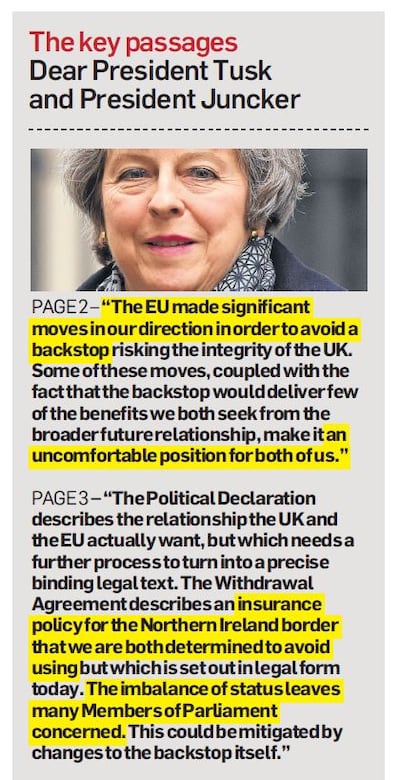The thrust of the EU’s reassurance letter to the UK on the “backstop” is: neither side likes it, it is far from ideal but it would only be temporary until we figure out a better deal, which we will definitely try to find.
Despite soothing tones, Brussels has conceded no new ground to British prime minister Theresa May on the insurance policy within the proposed EU-UK divorce deal to avoid a hard Irish border after the UK quits the EU on March 29th that has created so much political division at Westminster.

Instead, the EU has attempted to offer explanations and reassurances around what has already been agreed that might help her secure support in the House of Commons vote on Tuesday.
They are unlikely to help because, despite this round of correspondence between the EU and the UK on Brexit, the view in Brussels remains unchanged: the withdrawal agreement is untouchable and there is no legal guarantee to avoid the use of the backstop.
European Council president Donald Tusk and European Commission president Jean-Claude Juncker go over many of the EU's standing positions in their five-page letter to the British prime minister, though offer further "clarifications" around some of the concerns that May shares in her own five-page letter to them.
The EU reiterates the view that the withdrawal agreement cannot be changed but repeats that it hopes to establish an alternative plan by the end of 2020 so the backstop will not be triggered. If it were, then it would only remain in place “unless and until” - those three key words again - a subsequent agreement ensures that a hard border is avoided, Tusk and Juncker argue. They say they intend to work hard to find that agreement.
‘Fair compromise’
May, in her letter, accepts that the backstop represents “a fair compromise” but tries to find common concerns on both sides. She says some on the EU side fear that the UK could use the threat of a hard border as leverage in future trade talks, while some on the UK side fear the EU will not engage in those talks, intent on leaving the UK under EU economic rules through the triggering of the backstop.
She addresses British concerns about the backstop being legally binding while the political declaration committing the UK to avoid it is not. She asks the EU to confirm “the legal connection” between the two documents so that the British are not stuck with one and not the other.
Tusk and Juncker respond that the European Council’s conclusions on agreeing a deal to avoid the triggering of the backstop have “legal value” and that the withdrawal agreement and the political declaration are “part of the same negotiated package” but there are no legally binding assurances to avoid the backstop.

May asked Brussels for a commitment that exploratory talks can begin as soon as the UK parliament votes for the deal. Tusk and Juncker reply that they are willing to engage on a “work programme” if this happens.
She requested the EU gives “particular urgency” to work on ideas for an alternative to the backstop including “all available facilitative arrangements and technologies” - the long-standing “max fac” solutions much trumpeted by Brexiteers - for the Border. The EU (again) agrees they will be considered.
May says in her letter the UK reconfirms it will not let regulatory divergences develop between Northern Ireland and Britain "without the consent of the political institutions of Northern Ireland" and the scope of Northern Ireland's alignment with EU rules under the backstop would be "strictly limited."
Tusk and Juncker respond that this alignment would “not extend” beyond what is “strictly necessary” to avoid a hard border and to protect the 1998 Belfast Agreement, which both sides agree will not be affected.
The EU says there is nothing in the withdrawal agreement that prevents the UK from permitting the participation of the Northern Ireland Executive in the “joint committee,” the all-powerful EU-UK body that will decide on when and if the backstop should be triggered and ended.
One issue on which both sides agree is that the backstop is far from perfect.
May in her letter says it makes “an uncomfortable position for both of us.” Tusk and Juncker say it “represents a suboptimal trading arrangement for both sides.”
These statements, along with the EU’s clarifications and reassurances that will fall short for many Brexiteers, are unlikely to do much to help May’s case when it comes to Tuesday’s vote.










